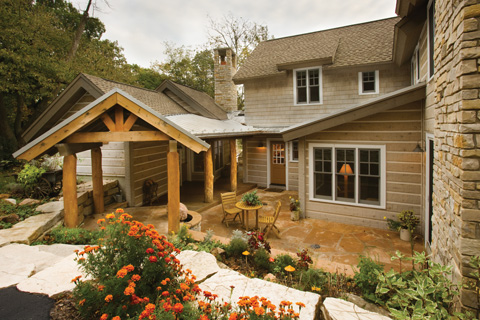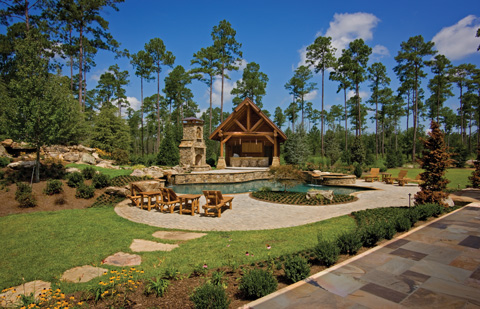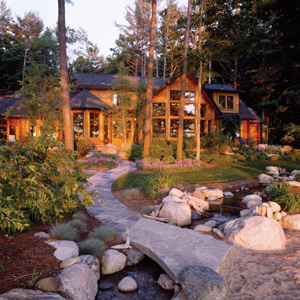It’s never too soon to start planning the landscape around your log home to ensure you won’t spend every weekend on lawn and garden chores. In fact, Kent Worley, Grand Rapids, Michigan, landscape architect, emphasizes the importance of including site considerations when you begin to design the home. He asks his clients to make a list of personal preferences including types and seasons of outdoor uses, expectations of care and maintenance, storage needs, preferred plant types, lawn area, snow removal operations, and snow storage areas.
Landscape designer Betsy Danielson, owner of Dazzle Gardens in Sandstone, Minnesota, has a general order of tasks when designing a landscape. “I usually do an inventory of all existing structures, hardscapes, and plants,” she says. “Is the house nestled into the side of a mountain surrounded by mature aspens? Is it part of a ranch setting with wide, open prairies? Or is it lakeside with a North Woodsy feel and plenty of pines and birches. First she creates an overall concept. Next she provides circulation by incorporating paths considering lines and geometry. Then she installs hardscapes like steps, decks, patios, fences, and walls. Last she chooses the plants.
Maintenance is a key issue in planning the landscape. Worley asks how much time per week his clients want to spend in their yards. Are they interested in minimizing mowing and lawn care needs? Landscapers across the country have their own favorite plants, materials, and methods to reduce maintenance. Danielson says the most important consideration is to plant the right plant in the right spot. “Consider the mature height and spread of the plant to eliminate the need for pruning in future years. Don’t plant a white pine three feet from a structure,” she says. “Consider a plant’s light and moisture requirements to avoid excess watering. Incorporate some ground covers, and limit the amount of turf grass.” You might also limit the size and scope of flower and vegetable gardens, and choose instead larger woody plants.
To save on labor, look for “No-Mow” grass mix, a special blend of low-growing fescue turf grasses that forms a dense lawn yet requires little or no watering or fertilizing. It only needs to be mowed once or twice a year. “It’s a terrific product,” says Ely, Minnesota, landscape designer Karen Nielsen-Friedrich, “and if you prepare the soil properly, you increase your chance of success. The first year it’s just crucial to get it going, so we usually mow it before any weeds have time to flower and seed, and we keep it well watered until it’s established.” Contact your local university extension office for a source near you.
Go for low maintenance when choosing hardscape materials. Wood bark paths are beautiful and blend nicely into natural landscapes but they require lots of upkeep. “You might want to add structures such as a pergola, arbor, trellis, arch or obelisk to provide the essential vertical plane,” suggests Danielson. “Think not only about tables and chairs, but statues, containers (full or empty,) water features like basins and bird baths, fire pits, whimsical touches or personal artistic endeavors.”
Most landscapers recommend mulching. “Mulches protect plants in winter and summer, hold in moisture and help with weed control,” says Bonnie Holloway, owner of Emerald Gardens in Longview, Texas. “Pine straw, hardwood, or cypress mulches do not float and are a good investment.” Shredded wood mulches are very versatile. They can be blown or raked out easily, and with a little top dressing every couple years, they look brand new.

Wisconsin Log Homes/photo by Roger Wade
Holloway says selecting dwarf, slow-growing shrubs for low porches and low windows means little pruning. She’s especially fond of a new shrub rose called EarthKind Landscape Rose. This new type of rose requires no soil amendments, no fertilizer, no spraying and water only every 21/2 weeks. Holloway likes to include some of these roses in what she calls a “welcome home garden,” a small bed by the garage.
Creative use of rocks as retaining walls and even purely unplanted areas can result in attractive landscapes while helping reduce maintenance. Whether it’s a gathering area near the entry, walkways, decks, or patios, these spaces don’t need to be watered or mowed. Nielsen-Friedrich is incorporating more hardscape into her designs including dry stream beds with native grasses and evergreen shrubs. Many log home owners include rock in their landscapes because it blends so well—especially if it’s the same stone that is used on the home.
While there are no magic bullet plants or systems that completely eliminate the need for maintenance, there are ways to reduce it. Careful soil preparation and plant selection will help guarantee a good result. Be realistic about the time and energy you want to spend on caring for your landscape and the budget you can devote to it. Thoughtful planning will result in attractive surroundings that will enhance the beauty and the value of your log home.


